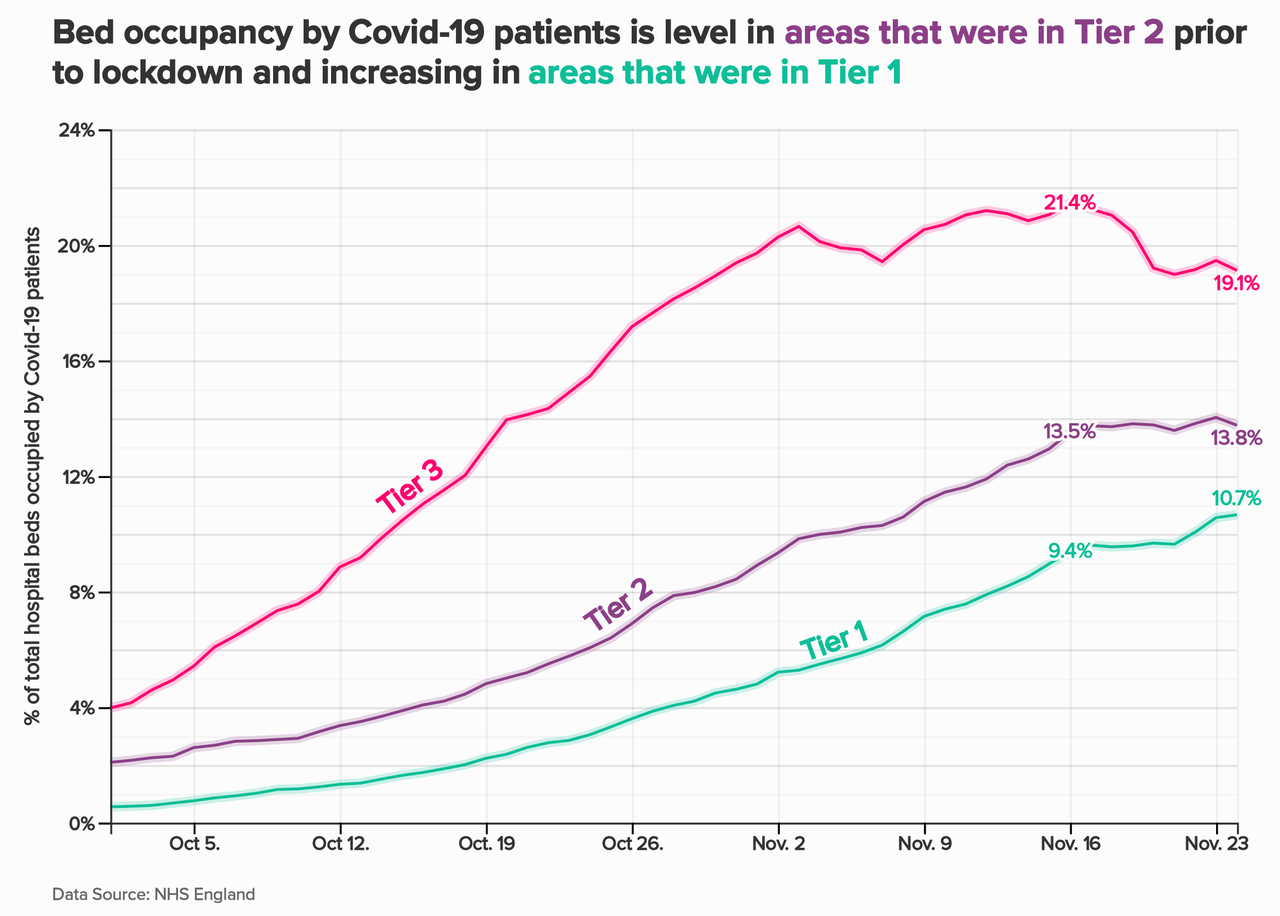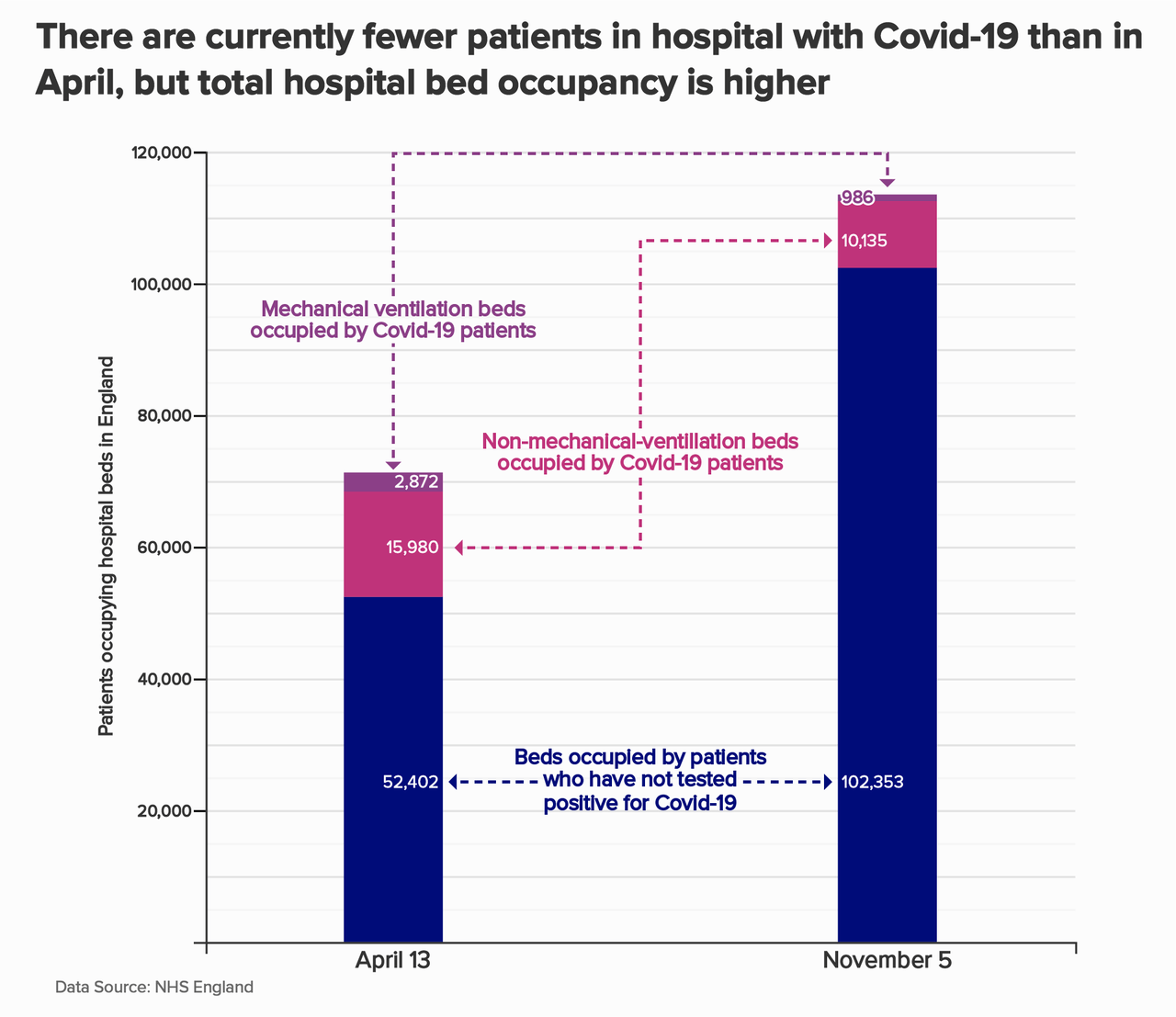The number of Covid-19 patients in hospital has fallen in areas that were under tier 3 lockdown, but risen in areas that were in tier 1, analysis by HuffPost UK has revealed.
It may help explain how some areas that were only in tier 1 before the national lockdown have ended up in tier 3 from Wednesday.
Our findings bear out warnings by Public Health England’s Dr Susan Hopkins and the government’s Sage (scientific advisory group for emergencies) advisers that tier 1 measures were insufficient to slow the pandemic.
Overall, the the number of people in hospital with Covid-19 fell last week for the first time since August – driven by the tier 3 areas, with tier 2 areas maintaining relatively flat numbers and tier 1 hospitals seeing more patients than before.
After reaching a peak of 14,712 hospital beds occupied by Covid-19 patients on November 23, the national number has fallen by 1,000 – a 7% decrease in less than a week.
The fall in patients marks a sharp reversal from a fortnight ago, when the number of beds occupied by Covid-19 patients was increasing at a rate of 19% a week.

Bed occupancy by Covid-19 patients is falling quickest in the north-west and Yorkshire, where many areas were placed in tier 3 – the highest level of local restrictions – prior to the national lockdown on November 5.
Liverpool was the only city to be placed in tier 3 when the government unveiled the three-tier system in October. Within two weeks of the announcement, Liverpool University Hospitals Trust had almost twice as many Covid-19 patients as any other hospital trust in England. But since then, the number of Covid-19 patients occupying beds in the trust’s hospitals has fallen by 45%.
Greater Manchester entered tier 3 on October 23. Collectively, the seven acute trusts that operate across the area have seen a 15% fall in patients with Covid-19 following a peak on November 16.

In the Midlands and south of England, however, the number of beds occupied by Covid-19 patients continues to rise.
Patient levels are growing fastest for the East Kent Hospitals University Trust and Medway Foundation Trust; collectively, the trusts have seen a fivefold increase in occupied beds in the past three weeks.
On Thursday, health secretary Matt Hancock revealed that Kent and Medway would be in tier 3 once the national lockdown ends on December 2.

Overall, the number of patients with Covid-19 is now 30% lower than at its peak (on April 13) during the pandemic’s first wave.
However, since April, as hospitals resume non-urgent procedures, there has been a steady increase in patients in hospital for reasons other than Covid-19.
On November 5, the latest date for which data are available, 102,000 beds were occupied by non-Covid-19 patients, compared with just 52,000 beds on April 13.

Writing in The Times on Saturday, cabinet minister Michael Gove said that without the national lockdown in November, hospitals would have been “physically overwhelmed” with “every bed, every ward occupied”.
Gove added that the tiers in place prior to the lockdown were “neither strong enough to reduce social contact sufficiently, nor applied widely enough to contain the virus’s spread”, and described the new three-tier system as “stronger” and “tougher”.
Dr Louise Dyson, an epidemiologist at Warwick University who sits on SAGE’s pandemic modelling sub-group (SPI-M), told HuffPost UK that falling new cases – followed with a delay by falling hospital bed occupancy rates – provided evidence that the very highest tiers prior to national lockdown were “just about reducing R slightly below 1.”
After reaching a peak during the first pandemic wave in mid-April, the number of patients in hospital with Covid-19 roughly halved each month until August.
But Dyson said occupancy rates were not guaranteed to decline in the same way during this second wave, adding that “keeping transmission under control was always going to be harder in the winter”.
During the summer, non-essential shops did not reopen until eight weeks after the peak in occupied beds; this time, lockdown is due to end just nine days after the peak.
And just a month on from the second wave peak in bed occupancy, on December 23, restrictions will be eased for a five-day window over Christmas, during which people will be allowed to travel freely and form temporary three-household bubbles.
Dyson said it is unclear how people will respond to the temporary easing of restrictions, and so it is particularly hard to model the impact of the Christmas window on transmission.
“Of course, all of these [eased restrictions] will increase transmission,” she said. “One of the worrying things about this kind of interaction is that there is lots of intergenerational mixing, so there’s a worry that it will lead to more cases in older people.”
Editor’s note: This story was amended to correct a reference to infections falling rapidly in the north-east. The sentence should have referred to the north-west.
